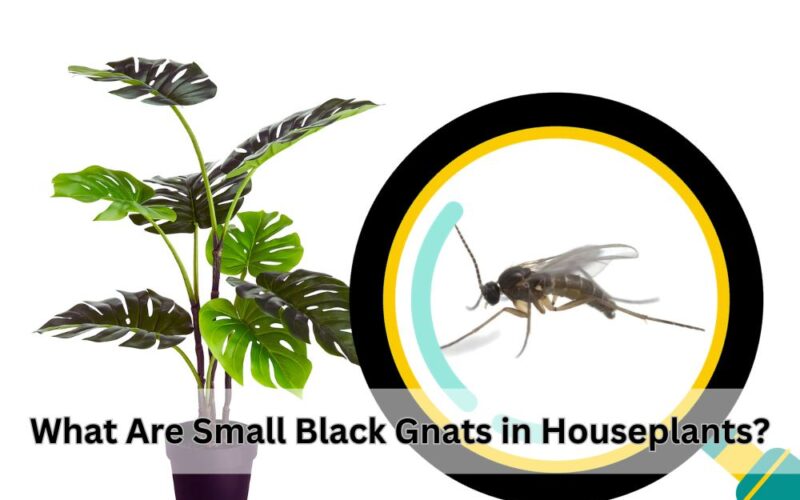If you spot small black gnats in houseplants and are searching for “Are they harmful to my indoor plant” and “How can get rid of them?” Join this article to find the best answers with all the things you must know. soil gnats are common tiny bugs on houseplants.
What Are Small Black Gnats in Houseplants?

First, let to get familiar with these tiny gnats in houseplants. What are they and how much are harmful to your indoor plant collection?
You usually spot them while watering your house plant. Although there are several types of gnats or small flies around houseplants, the common type is Fungus Gnats also known as Soil Gnats.
They belong to the family Sciaridae including various species. One common species found in indoor plants is Bradysia impatiens.
If you spot them under a magnifying glass, they are tiny flies (about 1/16 to 1/8 inch long) with narrow legs. As you can see in the picture Fungus Gnats have light grey or clear wings and segmented antennae that are larger than their heads.

These small black gnats cannot bite you or your pet. Indeed, they cannot hurt your indoor plant too. the harmful stage of them is their larvae that feed on the root of your plant. They are about 1/4 inch long with translucent white or grey bodies and blackheads.
As you can see in the below picture (the lifecycle of soil gnats on houseplants), the adults lay egg in the wet soil and their larvae feed on the organic matter of soil including the roots of your indoor plant. they are similar to tiny white dots on potting soil.

Let’s find the symptoms of the infested plant.
What Are the Symptoms of an Infested Plant?
As I told you above the harmful stage of these pests is their larvae that feed on the roots, hence if you spot the sign of the root rot along with tiny flies surrounding your plant, you must think about fungus gnats’ infestation.
In the following, I tell you common signs of root damage in plants.
- Plant growth stop
When the roots are damaged, the plant’s ability to absorb nutrients will decrease, hence your plant cannot grow more.
- Yellowing the leaves
When the root cannot absorb nutrition, the leaves will show the symptoms of nutrition deficiency and yellowing is one of the first symptoms that will result in leaf drop
- The death of plants due to root rot.
The damaged root will be attacked with parasitic or even secondary fungi in soil which will result in root rot and plant death.
Now come on to find out what factors cause the fungus gnats to attract to your houseplant. keep reading.
What causes Small Black gnats in houseplants?

In this part, I want to tell you about the favourite environmental conditions of soil gnats. It is very important, do you know why? when you know about the factors that increase the risk of fungus gnat infestation, you can prevent them.
As a general rule in plant protection science, prevention is always easier and cheaper than treatment. In the following, you can find things that attract small black gnats to your indoor potted plant. let’s find them.
- A rich soil with a lot of organic material.
As I told you before, the adults lay eggs on the top soil (first couple of inches) and the larvae feed only on the organic debris including roots. So, the adults always be attracted the soils that are rich in organic debris.
- Wet soil
The fungus gnats must lay eggs in soils with high humidity. So, if you keep the soil wet consistently, you will increase the risk of the soil gnats’ infestations. so, the pots without drainage holes are not suitable for these conditions.
- Warm environments
the best temperature for fungus gnats is between 70 – 80 degrees Fahrenheit. The adults are also attracted to lightings so you may spot them while flying around the lamp or bright window.
know you are ready to prevent these small black gnats in houseplants by preventing their favourite environments. If you are interested in knowing more tips on this issue, I discussed preventing gnats in houseplants in another post that you can read.
Anyway, if you spot the symptoms of fungus gnats in your indoor plant, keep reading to find out the best way to kill gnats in houseplants.
How To Get Rid of Fungus Gnats in Houseplants Naturally?

Here, you will find out What home remedy kills gnats in houseplants including spray for gnats in indoor plants. let’s start.
1-Hydrogen peroxide for gnats in houseplants
Hydrogen peroxide can kill the larvae of gnats in houseplants without injuring your plant. To make your DIY pesticide you must mix:
- One part of hydrogen peroxide
- Four parts of water
Now water your houseplant with the above solution and repeat every week until you can control the soil gnats.
2-How to get rid of gnats in houseplants with vinegar?
It’s a kind of gnats’ trap that is very easy. you must pour apple cider vinegar into a cup and add a few drops of dish soap. After that provide a lid for the cup with tape or cheesecloth and create holes large on it. please the cup near your indoor plant and let the fungus gnats attracted by the scent of apple cider vinegar. They will try to drink it and will drown.
If you are interested in learning other kinds of traps, I discussed how to trap gnats without apple cider vinegar. You can read it.
3- Natural Spray for Gnats in Houseplants
You can make your homemade pesticide sprays to control soil gnats. Here is one of the best.
Soap Acts as an Insecticide
Mix a horticulture soap with water and pour it into a bottle. Very easy. you can spray the soil every week with this spray until you control the fungal gnats.
Neem oil is also effective on fungus gnats. I discussed it in my previous article.
4: Kill the Fungal Gnats by Dry Out the Topsoil
As I told you above, the adults lay eggs in wet soils and larvae live in soils with high humidity, so you can kill them by drying out several inches of topsoil. hence, before watering, touch the topsoil, if you feel it drought, start watering.
In addition, Diatomaceous Earth for Gnats in Houseplants can help you with this issue. I discussed it in my previous article about silver tiny bugs on houseplants.
5: Biological Control of Small Black Gnats in Houseplants
One of the common botanical controls is Bacillus thuringiensis subspecies israelensis (Bti). It’s usually in granule forms that you must sprinkle them over the soil. after watering will release some bacteria inside the soil and control gnats without any risk to people or pets
Read about the nematodes for fungus gnats in houseplants too.
Conclusion
In this post, I told you about small black gnats on houseplants. I showed you the symptoms of an infested plant and discussed the favourite environments for soil gnats. I also provided you with natural homemade remedies to get rid of the fungus gnats.
Do you know other ways to kill fungus gnats in houseplants? did you control this indoor pest with the above treatments? Which one? please share your experiences and ideas with our readers below this page and ask me your questions, I will answer as soon as possible.

Elahe Rabiei
Hi, I’m Elaheh. My Academic major is plant protection, and houseplants are my expertise. As a houseplant lover, my house is full of indoor plants and it is my passion to take care of them. Hence, I’m here to share my knowledge and experience about growing healthy houseplants. I am also a plant protection advisor, so feel free to ask me any questions you may have.

